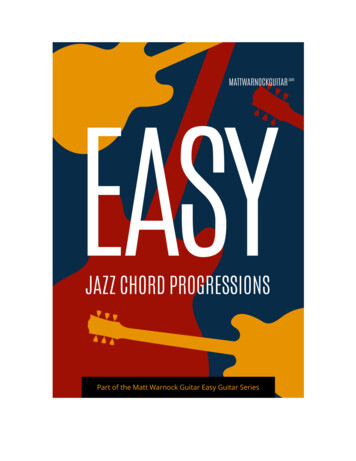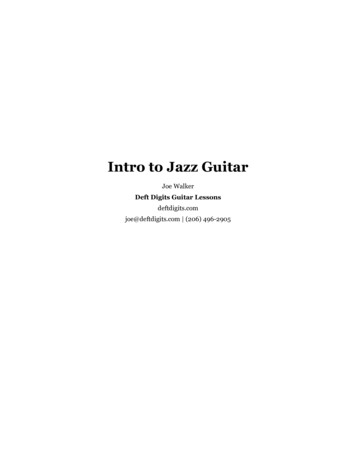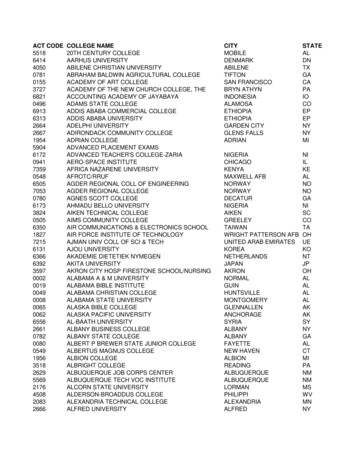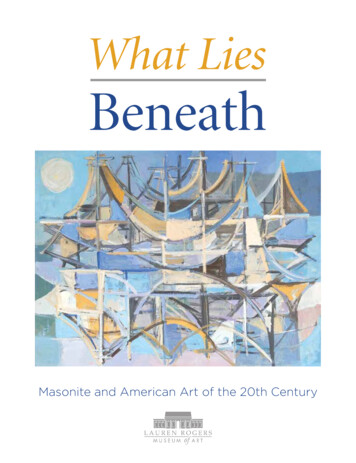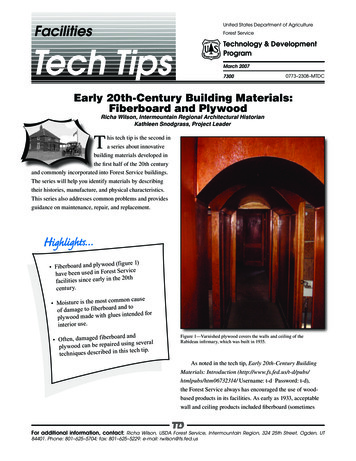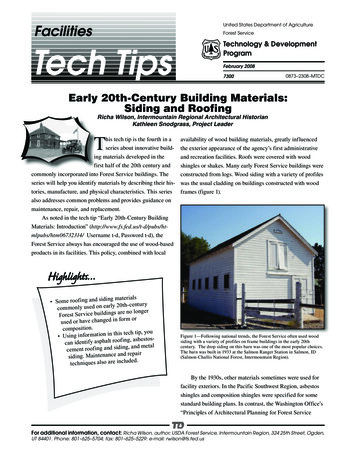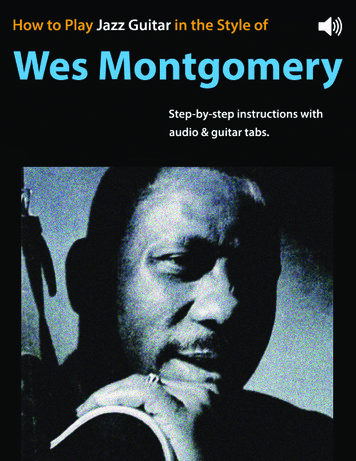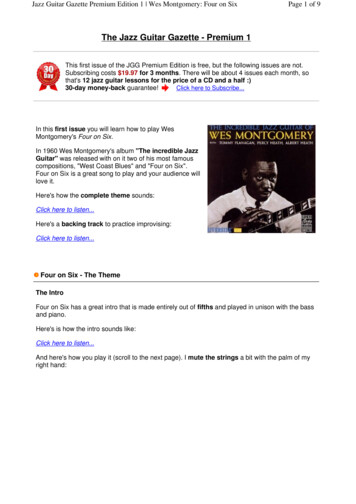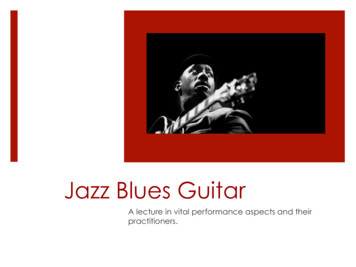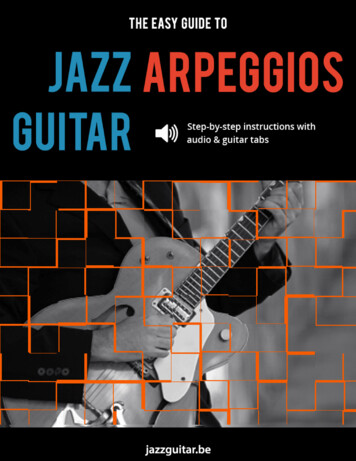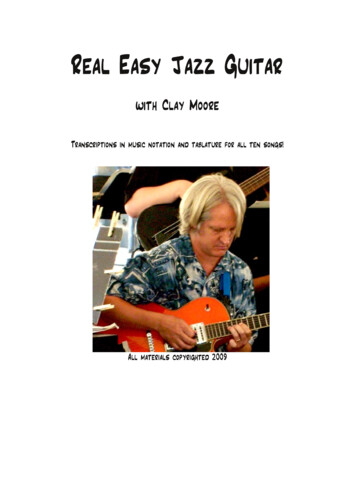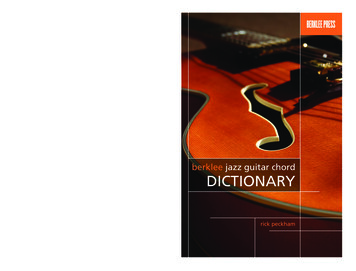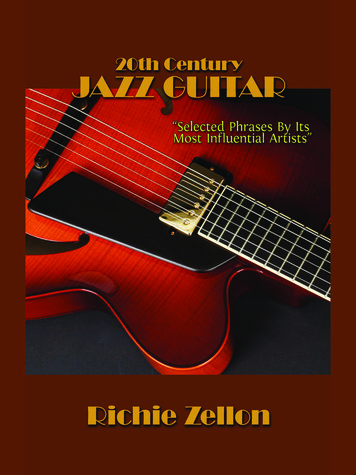
Transcription
20th CenturyJAZZGUITAR“Selected Phrases By Its Most Influential Artists”Richie ZellonThis Book Is Strictly For Educational Purposes. Its Sale is Prohibited.
About This BookThis book is a compilation of short phrases I transcribed during a period of several years to complement and aid in the education of my jazz guitar students. Indoing so, I chose to represent only 16 influential soloists in the history of jazzguitar, from its inception in the early 20th century up until its close. As a result,several artists who did not garner the recognition required to become “household” names in the world of mainstream jazz guitar, have not been featured here.Doing so would defeat the initial purpose of this collection which is to providebrief samples of each stylistic era within the evolution of jazz guitar. Sad to say,among those left out are some of my personal favorites! Others who were notrecorded extensively, but are known to have influenced some of the better knownplayers of their era, have also been omitted. To name a few- from the Swing Era:Eddie Lang, Carl Kress, Freddie Green (not a soloist), Oscar Aleman, George Barnes,George VanEps, Bucky Pizzarelli; from the Bebop Era: Oscar Moore, Tiny Grimes,Bill DeArango, Billy Bauer, Billy Bean, Chuck Wayne, Joe Puma, Sal Salvador, HerbEllis, Johnny Smith, Barry Galbraith, Howard Roberts; from the Post-Bop Era:Attila Zoller, Joe Diorio, Ralph Towner, Lenny Breau, Ed Bickert, & Mick Goodrick.Although the outline of stylistic eras in this book includes the Fusion Era, I havenot included transcriptions of several of its leading proponents, due to the factthat my goal has been to concentrate on mainstream jazz guitar. In spite of this,I believe the following fusion players deserve a mention here, as they have delvedinto uncharted territory on the guitar and have opened up new possibilities at thecreative and technical level: John McLaughlin, Larry Coryell, Allan Holdsworth, AlDimeola & Frank Gambale. Last but not least, I feel indebted to name some of theleading players in the Gypsy Swing revival that began towards the closing of the20th century: Bireli Lagrene, Bolou Ferre & Stochelo Rosenberg.The inclusion of each player’s profile and selected discography, was an afterthought to the transcriptions and is not intended to be the primary focus ofthis book. However, I felt this would provide my new jazz guitar students withsome brief historical background regarding each artist. Even though most of thisinformation is readily available throughout the internet, for those desiring a moredetailed account into the life of each player, I recommend the well researchedbook by Scott Yanow,“The Great Jazz Guitarists: The Ultimate Guide”.To conclude, I would like to share with those guitarists who are new to the art ofjazz improvisation, some thoughts regarding the study of the transcriptions herein. Let me begin by saying that jazz is a language with a unique grammar, somewhat functionally similar to that of a non musical language. To fluently conversein it, we must be in the moment and interact, both with our surrounding musicians as well as our immediate audience. Furthermore, to be understood by itsnative practitioners we must first become familiar with the idiomatic phrases4
that make up its vocabulary. That said, we will never properly learn to improvise fluently by merely playing the phrases included in this book, outside of theharmonic and thematic context they were originally played in. These phraseswere not performed as memorized licks or riffs by their executioners—they wereextracted from a cohesive unit of melodic ideas, spontaneously woven into a soloover a given set of chord changes. This in turn is the result of each performer having spent years studying the construction of jazz lines from their predecessors,and perfecting the technical resources required to play them!This collection of phrases is meant to provide the student with a glimpse intothe creative mind of each artist when analyzing the melodic composition of hislines. In doing so the aspiring improviser will gain knowledge as to how a masterplayer combines a set of harmonic resources (eg. scales, arpeggios) to create hisvocabulary. To facilitate this, each transcription has been identified by cadence(eg. II-V). Consequently, in order to derive improvisational vocabulary modeledafter a transcription, a working knowledge of harmonic and melodic analysis isrequired on behalf of the student. The lack thereof, will otherwise lead to thememorization of a phrase that has no continuity in a solo; versus the spontaneousconstruction of that which seamlessly fits into the context of the given harmony.If you are among those guitarists seeking a thorough understanding of how toconstruct jazz lines versus playing memorized licks when improvising, I wantto take this opportunity to introduce you to the Bebop Guitar Improv Series.This is a comprehensive 1 year e-course consisting of 150 hd videos which willtake you from the ground up through all the rudiments of jazz improvisation. Itis exclusively guitar oriented and all the lessons include both regular notation aswell as tablature. In addition, you will benefit from an information filled forumthrough which I will personally answer all your jazz guitar related questions. Thisand much, much more is available at an incredibly low price! For more information please e-series.htmlLast but not least, please be informed that I have personally played and demonstrated most of the transcriptions featured in this book on a series of videos whichhave been posted on “The Jazz Guitar Channel” on YouTube.Thanks for downloading this free e-book. Enjoy!Richie Zellon5
About The AuthorRichie Zellon, guitarist, composer,and music educator, has held teaching positions as professor of jazz guitar at Florida International University(Miami) the University of South Florida (Tampa) The Music Workshop(Orlando) and his own venue, MiamiJazz Guitar.With several critically acclaimedrecordings under his name, Zellon hasrecorded and performed with some ofthe most influential musicians both in the mainstream and Latin jazz genres.Among them, Paquito D’ Rivera, David Leibman, Jerry Bergonzi, Sam Rivers,George Garzone, Danilo Perez, Edward Simon, Jeff Berlin, Abraham Laboriel,Oscar Stagnaro, Alex Acuna and Ignacio Berroa to name a few.Due to his innovations in the field of jazz and latin music he has been profiledin several important books such as “The Great Jazz Guitarists” by Scott Yanow,“The Jazz Guitar: Its Evolution, Players and Personalities Since 1900” by Maurice J. Summerfield, “El Diccionario de Latin Jazz” by Nat Chediak, “Caliente:A History of Latin Jazz” by Luc Delanoy and “Jazz Jews” by Michael Gerber.For almost a decade, he wrote an instructional column for Jazz Improv magazine. In addition to his dedication to mainstream jazz, his ongoing research onthe music of various Latin American cultures and their fusion with contemporary music has been a sought after topic by musicians at international clinicsand workshops as well.For more information please visit jazzguitar.richiezellon.com6
ContentsThe StylesThe Swing Era. 9The Bebop Era.10The Cool Era.11The Hard Bop Era. 12The Post Bop Era. 13The Fusion Era. 14The PlayersDjango Reinhardt. 16Charlie Christian. 22Barney Kessel . 27Tal Farlow. 34Kenny Burrell. 39Jimmy Raney. 46Wes Montgomery. 51Joe Pass. 60Grant Green. 68George Benson. 73Pat Martino. 79Jim Hall. 86Pat Metheny. 94John Scofield. 100John Abercrombie.106Mike Stern. 1117
TheStylesBRIEF SYNOPSIS OF THE STYLISTIC EVOLUTION OF JAZZThe guitar first played an important role in Blues and Dixielandprior to the 1930’s. However, it wasn’t until after this period intime that the guitar began developing its own sophisticatedvoice and was first featured in jazz improvisation at par with thepiano, brass and woodwind soloists. In lieu of this fact, I havechosen to begin this synopsis of the evolution of jazz, with theSwing Era.8
The Swing Era(1930’s)The Swing Era’s most prominent contribution to jazz is believedto be by many, the introduction of the “big band” orchestraformat. In addition to a combination of brass, woodwinds, and arhythm section, until the 1930’s most dance orchestras alsoincluded a string section. The string instruments were droppedfrom the format and the new orchestras were streamlined forthe new daring swing arrangements which featured not onlyhighly orchestrated music influenced by European traditions, butalso a soloist who after taking center stage, would improviseover the framework of the entire piece. It was not unusual forother soloists to join in sometimes and engage in collectiveimprovisation, a practice already common when performingBlues and Dixieland.9
The Bebop Era(1940’s)Most Jazz historians agree that the foremost architects of theBebop era were trumpeter Dizzy Gillespie, saxophonist CharlieParker and pianist Thelonious Monk. Along with bassist MiltHinton, and drummer Kenny Clarke, the quintet began jamminginformally at “Mintons Playhouse” (Harlem, NY.) in 1941. Due toa fight between the American Federation of Musicians and therecord labels, a two year ban took place on all recordings thusnot allowing this new jazz idiom to be documented on recorduntil 1944.Bebop musicians experimented with various sophisticated concepts of improvisation, harmonic substitutions, polyrhythms anddeveloped a higher degree of interaction between the soloistand the rhythm section. In doing so they set the foundation forjazz improvisation as we know it today. Unlike the soloists of theSwing Era, when improvising they were not bound (swayed) bythe main melody of the piece. As a matter of fact, many Beboporiginals were created as the result of an improvised solo playedover the chord progression of a familiar standard (e.g. Parkers“Anthropology” & “Dexterity” are based on “I Got Rhythm”,“Ornithology” is based on “How High the Moon”, “Donna Lee”is based on “Indiana” and Bud Powell’s “Hot House” is based on“What is this thing called Love”)By mid World War II, Bebop began to be embraced by manyjazz musicians as their preferred idiom. As a result jazz wastransferred from the dancehall back to the small club and likewise from the big band to the small combo. Jazz was no longermusic for the masses and its popularity was never recoveredfrom that day on. As the music moved away from big business,it became an art form reserved for a niche of musicians and jazzconnoisseurs forcing the major labels to explore other marketsfor their source of profit. This gave rise to several small independent jazz labels such as Blue Note, Prestige and Savoy, whospecialized in catering to that loyal minority of followers that haskept the music alive to the present day.10
The Cool Era(1950’s)The Cool Jazz sound evolved in the early 1950’s as a result ofthe influx of new white musicians entering the jazz scene andmixing with the predominantly black bebop musicians. Thisgave rise to a less aggressive sound and introduced new instrumental textures as well as compositions and arrangements thatdrew several elements from 20th century European music.Miles Davis became a major influence with his 1950 groundbreaking recording entitled “Birth of The Cool”, featuring a nonetwith arrangements by Gil Evans. This era heralded Davis’srelaxed style of soloing, emphasizing the use of space.The Cool Jazz era is also synonymous with a new movementthat developed in the West Coast and introduced other important musicians such as Gerry Mulligan, Chet Baker, Lee Konitz,Paul Desmond and Dave Brubeck who made his mark with hisnow classic “Take Five” recording.11
The Hard Bop Era(Mid 1950’s)By the mid fifties bebop had declined and many young jazzmusicians were listening to rhythm and blues. As a result itsinfluence started being heard in their compositions as well asimprovisations. This new sound became known as Hard Bopand its birth is marked by several recordings released in 1954primarily featuring Art Blakey and the Jazz Messengers, HoraceSilver, Miles Davis and Clifford Brown. These musicians all knewthat the only way to get the jazz audience back and be successful again was to make music that was memorable. Thereforethe complex bebop compositions in the style of Charlie Parkerand Dizzy Gillespie were replaced by simpler more “groove oriented” melodies that universal audiences could relate to easier.12
The Post Bop Era(Lat
guitar, from its inception in the early 20th century up until its close. As a result, . construct jazz lines versus playing memorized licks when improvising, I want to take this opportunity to introduce you to the Bebop Guitar Improv Series. This is a comprehensive 1 year e-course consisting of 150 hd videos which will take you from the ground up through all the rudiments of jazz .
